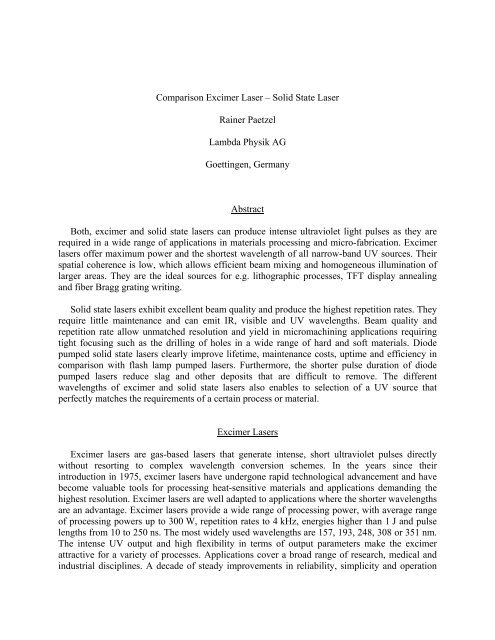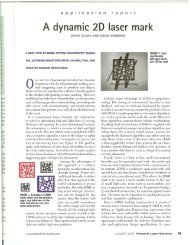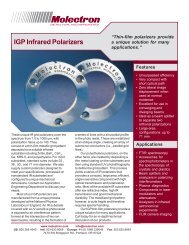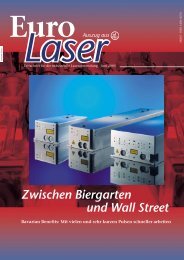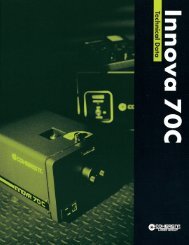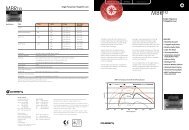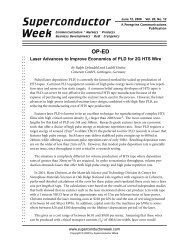Comparison Excimer Laser – Solid State Laser Rainer ... - Coherent
Comparison Excimer Laser – Solid State Laser Rainer ... - Coherent
Comparison Excimer Laser – Solid State Laser Rainer ... - Coherent
You also want an ePaper? Increase the reach of your titles
YUMPU automatically turns print PDFs into web optimized ePapers that Google loves.
<strong>Comparison</strong> <strong>Excimer</strong> <strong>Laser</strong> <strong>–</strong> <strong>Solid</strong> <strong>State</strong> <strong>Laser</strong><br />
<strong>Rainer</strong> Paetzel<br />
Lambda Physik AG<br />
Goettingen, Germany<br />
Abstract<br />
Both, excimer and solid state lasers can produce intense ultraviolet light pulses as they are<br />
required in a wide range of applications in materials processing and micro-fabrication. <strong>Excimer</strong><br />
lasers offer maximum power and the shortest wavelength of all narrow-band UV sources. Their<br />
spatial coherence is low, which allows efficient beam mixing and homogeneous illumination of<br />
larger areas. They are the ideal sources for e.g. lithographic processes, TFT display annealing<br />
and fiber Bragg grating writing.<br />
<strong>Solid</strong> state lasers exhibit excellent beam quality and produce the highest repetition rates. They<br />
require little maintenance and can emit IR, visible and UV wavelengths. Beam quality and<br />
repetition rate allow unmatched resolution and yield in micromachining applications requiring<br />
tight focusing such as the drilling of holes in a wide range of hard and soft materials. Diode<br />
pumped solid state lasers clearly improve lifetime, maintenance costs, uptime and efficiency in<br />
comparison with flash lamp pumped lasers. Furthermore, the shorter pulse duration of diode<br />
pumped lasers reduce slag and other deposits that are difficult to remove. The different<br />
wavelengths of excimer and solid state lasers also enables to selection of a UV source that<br />
perfectly matches the requirements of a certain process or material.<br />
<strong>Excimer</strong> <strong>Laser</strong>s<br />
<strong>Excimer</strong> lasers are gas-based lasers that generate intense, short ultraviolet pulses directly<br />
without resorting to complex wavelength conversion schemes. In the years since their<br />
introduction in 1975, excimer lasers have undergone rapid technological advancement and have<br />
become valuable tools for processing heat-sensitive materials and applications demanding the<br />
highest resolution. <strong>Excimer</strong> lasers are well adapted to applications where the shorter wavelengths<br />
are an advantage. <strong>Excimer</strong> lasers provide a wide range of processing power, with average range<br />
of processing powers up to 300 W, repetition rates to 4 kHz, energies higher than 1 J and pulse<br />
lengths from 10 to 250 ns. The most widely used wavelengths are 157, 193, 248, 308 or 351 nm.<br />
The intense UV output and high flexibility in terms of output parameters make the excimer<br />
attractive for a variety of processes. Applications cover a broad range of research, medical and<br />
industrial disciplines. A decade of steady improvements in reliability, simplicity and operation
has changed the excimer from a scientific to a production tool. The excimer’s gain medium is<br />
composed of inert and halide gases. <strong>Excimer</strong> is an abbreviated form of “excited dimer”, meaning<br />
a diatomic excited molecule with the same atomic composition; e. g., Xe2. The name excimer<br />
also is applied to molecules like XeCl.<br />
Figure 1: Typical Near field beam profile of a 248 nm excimer laser<br />
Figure 1 shows the typical beam profile of the excimer laser that is very similar for all<br />
wavelengths. The large dimension shows a top-hat profile whereas the short dimension gives a<br />
Gaussian intensity distribution. The main performance characteristics of the excimer and solid<br />
state lasers are summarized in Table 1.<br />
Table 1: <strong>Excimer</strong> performance characteristics<br />
Characteristic <strong>Excimer</strong> <strong>Laser</strong> Photon Diode pumped<br />
Energy ND:YAG<br />
Wavelength<br />
1.17 eV 1064 nm,<br />
2.33 eV 532 nm,<br />
351 nm,<br />
3.53 eV 355 nm<br />
308 nm,<br />
4.02 eV<br />
4-66 eV 266 nm<br />
248 nm,<br />
5.00 eV<br />
193 nm,<br />
6.42 eV<br />
157 nm<br />
7.90 eV<br />
Energy per Pulse 10 .... 1000 mJ 0.1 ... 3 mJ<br />
Repetition Rate 10 .... 4000 Hz 1 kHz ... 100 kHz<br />
Power Range 1 ... 300 W 5 ... 60 W<br />
Pulse Length, FWHM 10 ... 35 ns 15 ... 100 ns<br />
Beam Quality Large cross section,<br />
TEM00<br />
mutimode<br />
M 2 < 1.2<br />
Spatial Coherence Low High<br />
Max. Energy Density ... 200 J/cm 2 ... 2500 J/cm 2<br />
Max. Peak Power Density ... 1000 MW/cm 2 ... 200 GW/cm 2
The short wavelength of the excimer provides high optical resolution as required in microlithography<br />
for chip dimensions below 0.25 µm. On the other hand the photon energy of the UV<br />
wavelength is very high, even higher than the bond energy of several molecules that lead to a<br />
specific interaction. Only excimer lasers emit UV wavelength with acceptable efficiency and<br />
without additional frequency conversion.<br />
<strong>Solid</strong> <strong>State</strong> <strong>Laser</strong><br />
From the large range of solid state lasers in this paper, the diode pumped Nd:YAG laser will<br />
be considered in more detail. The advantage of diode pumping of solid state lasers is that the<br />
pump wavelength can be matched with the absorption characteristic of the laser medium. As a<br />
result a high efficiency is reached with unmatched beam quality. The beam quality allows for<br />
efficient frequency doubling and tripling using non-linear crystals. In such arrangements the<br />
fundamental wavelengths at 1064 nm, the visible 532 nm and the 355 nm UV wavelength can be<br />
generated with high efficiency and stability.<br />
Figure 2: Typical beam profile of a diode pumped solid state laser (GATOR)<br />
Diode pumped solid state lasers emit a so called “diffraction limited” beam quality (M 2 < 1.2)<br />
which provides the smallest possible size for micro-features.<br />
D ≈ (4 x λ x (f/D) x M2) / π<br />
Table 2 provides an overview of typical spot sizes and peak power densities for F numbers<br />
(f/D) of 10-20 as obtained by Lambda Physik’s DPSS <strong>Laser</strong> “PowerGator”:<br />
Table 2: DPSSL laser spot sizes and peak power densities<br />
Wavelength Spot Size Peak Intensity<br />
1064 nm 15-30 µm > 63 GW/cm 2<br />
532 nm 10-15 µm > 56 GW/cm 2<br />
355 nm 5-10 µm > 170 GW/cm 2
<strong>Excimer</strong> <strong>Laser</strong> Applications<br />
<strong>Excimer</strong> lasers are used in a variety of industrial applications that take advantage of the broad<br />
spectrum of output specifications. By far, the largest industrial application of excimer laser is<br />
found in micro-lithography. In this application the wavelengths of the excimer laser 248 nm,<br />
193 nm and 157 nm are a precondition to achieve the optical resolution required to print pattern<br />
of 180 nm down to 70 nm. The laser light is used to expose the photo-resist on the wafer. The<br />
scanners illumination system, which today must provide various illumination settings such as<br />
annular or quadrupole, is well adapted to the excimer laser beam. The excimer’s low spatial<br />
coherence helps to avoid speckle interference phenomena in the image. The refractive imaging<br />
lens of the scanner demands a very narrow output spectrum of less than 0.5 pm, FWHM in order<br />
to avoid chromatic aberrations. Another prominent application, which is dominated by the<br />
excimer laser, is the use for annealing of TFT flat panel displays. In this process the laser is used<br />
to transfer amorphous silicon into a poly-crystalline silicon which is then used to build up<br />
transistors and driver circuits. Only excimers deliver the wavelength (308 nm) and the required<br />
output power (300 W) to cost efficiently process the substrates. High power XeCl excimer lasers<br />
are also applied for the surface treatment of metal alloys like cast iron as used in cylinder liners<br />
of combustion engines. The ablation process using 308 nm wavelengths leads to opening of<br />
graphite spherulites which then act as an oil reservoir and greatly reduce wear and oil<br />
consumption.<br />
Micromachining with <strong>Excimer</strong> <strong>Laser</strong><br />
Micromachining is a large area in which both lasers, excimer and Nd:YAG are employed in<br />
various applications such as drilling, scribing, cutting and structuring. In general both lasers use<br />
different strategies to machine the sample. This difference can be described using the example of<br />
hole drilling.<br />
<strong>Excimer</strong> laser drilling utilizes a mask that is imaged onto the work-piece with some demagnification.<br />
The field size is determined by the energy density required for the ablation and<br />
the available energy of the excimer laser. In many material processing tasks a single pattern has<br />
to be repeated many times. Using masks with patterned arrays the large cross section of excimer<br />
beams can be utilized conveniently. Processing of most polymers with excimer radiation is<br />
usually performed at energy densities of about 1 J/cm 2 . Using 248 nm (KrF) or 308 nm (XeCl)<br />
leads to an ablation rate of about 1 µm per pulse. If small holes such as 20 <strong>–</strong> 50 µm have to be<br />
drilled, this implies that only a minute fraction of the laser beam is really needed. Therefore, a<br />
useful technique for a more economical use of the laser beam is the drilling of many holes<br />
simultaneously. The simplest set-up is shown in Figure 3.
Figure 3: Simple set-up for hole drilling with excimer laser<br />
A mask of 0.1 mm stainless steel or metal coated quartz contains the pattern on an area of<br />
4 x 12 mm. This area is small enough to be within the homogeneous part of the beam cross<br />
section. The field lens collimates the beam to ensure that only the center part of the imaging lens<br />
is used to minimize aberrations. A reduction ratio of three serves to increase the energy density<br />
on the work piece to about 1 J/cm 2 . In the above set-up only the homogeneous portion of the<br />
beam is utilized which corresponds to about 50% of the laser energy. Depending on the pattern,<br />
hole size and density, a certain portion of the beam contributes to the ablation process. To<br />
achieve optimal results, illumination and imaging optics have to be adapted precisely to the<br />
processing task. In order to increase the utilization of the excimer beam more optical elements<br />
must be added which homogenize the raw beam and illuminate the exact mask pattern. The<br />
principle of a high efficient homogenizer built by MicroLas ® is shown in Figure 4.<br />
Figure 4: Principle of Beam Homogenizer using crossed arrays of cylindrical lenses
It consists of crossed cylindrical lenses. The incident laser beam is cut into segments by a lens<br />
array and superimposed in the plane of integration. The more light segments are superimposed,<br />
the better the homogeneity. With such an arrangement about 90% of the laser energy are<br />
transferred into a homogeneous illumination field.<br />
The ink jet nozzle drilling into polyimide or KAPTON is one prominent example for the hole<br />
drilling by excimer laser. Utilizing 248 nm or 308 nm with energies of up to 1000 mJ allows cost<br />
effective drilling of complete nozzle plates in one process step as used for the ink jet printer<br />
industry.<br />
Figure 5: Nozzle plate of Ink-Jet-Printer produced by excimer laser drilling<br />
Other applications that also require a large and fixed pattern density are the production of<br />
multi-chip-modules, pcb and flex-pcb. Depending on the process, 308 nm or 248 nm<br />
wavelengths are utilized to ablate the insulator material such as Polyimide or Epoxy. Choosing a<br />
suitable energy density of i.e. 250 mJ/cm 2 enables to “drilling” through the insulation layer<br />
without affecting the underlying copper layer. The low energy density that is used for the<br />
ablation using 248 nm or 308 nm leads to a large process area and as a result low operating cost<br />
per work-piece.<br />
The treatment of hard materials such as Al2O3, ZrO3, Sapphire and Si3N4 ceramics is also<br />
achieved by 248 nm excimer laser with high precision. With energy densities of more than<br />
25 J/cm 2 suitable flank angles and surface roughness are achieved for the production of so called<br />
spinnerets. Spinnerets are used as tiny nozzles for chemical fiber production. The processing is<br />
carried out by means of the “projection technique” typical for excimer laser micromachining.<br />
With typical ablation rates of less than 0.1 µm per pulses structuring of a 200 µm ceramic plate is<br />
achieved in less than 20 seconds with 100 Hz repetition rate of the excimer laser. Using a similar<br />
set-up the excimer is also suitable for a variety of other applications such as electronics, sensors<br />
and medical technologies where these ceramic substrates are structured with high precision down<br />
to 10 µm.<br />
As shown in Table 1 the photon energy of the excimer wavelength is very high. Using<br />
193 nm or 157 nm wavelength gives an advantage for the machining of glass, quartz and PTFE,<br />
which are transparent at longer wavelength. PTFE is a mechanically, electrically and chemically<br />
stable material used in various applications from the life science to electronics industries. For the<br />
micromachining of PTFE longer wavelengths require high fluence and thermally overload the
material. Applying 157 nm leads to very clean results with no evidence of debris or thermal<br />
damage.<br />
Figure 6: PTFE processed at 157 nm<br />
Figure 7: Fused silica processed at 157 nm<br />
Figure 6 shows blind holes machined into PTFE by the 157 nm excimer laser using 1.4 J/cm 2<br />
energy density in a contact mask technique. The edges are well defined and the bottom surface is<br />
very smooth. Similar advantageous results are observed for other wide band-gap materials such<br />
as fused silica, which is fully transparent even at 193 nm wavelength. A processing result of<br />
fused silica is shown in Figure 7. Clean blind holes have been achieved without thermal damage<br />
or micro-cracking of the substrate.<br />
Micromachining with Nd:YAG<br />
<strong>Laser</strong> micromachining is emerging as a viable manufacturing solution due to the development<br />
of industrial grade diode pumped, short-pulse, frequency-multiplied solid-state lasers. Lamppumped<br />
Nd:YAG lasers with pulse length of several tenths milliseconds are well-established<br />
tools for drilling of metal alloys and composites. However, if high precision is required, laser<br />
drilling with milliseconds pulses could not fulfill the requirements up to now. The major problem<br />
is the melt produced when using long pulsed lasers. Irregular and incomplete melt expulsion<br />
affects the shape of the hole, produces recast layers and may even partially close a hole during<br />
the drilling process that was open initially.<br />
The radiation in short pulse, diode pumped solid-state lasers (DPSSL) results in beam and<br />
pulse characteristics that make these lasers a versatile tool for precision engineering. With a<br />
gaussian power distribution and a beam quality factor of M 2 = 1.1, the laser beam can be used for<br />
nearly diffraction limited resolution. A pulse peak power in the gigawatt range can be achieved<br />
on the sample. The excellent beam quality also ensures efficient frequency conversion. Metals<br />
are ideally processed at wavelengths of 1064 nm and 532 nm, while ceramics, glasses, and<br />
polymers are processed with minimal thermal effects by applying UV-laser radiation.
Figure 8: Process strategies to achieve high accuracy in laser drilling<br />
Different strategies have been developed for the Nd:YAG based laser drilling, which are<br />
chosen depending on the laser energy, hole diameter and required accuracy. Traditionally single<br />
pulse or percussion drilling has been applied. To achieve higher surface accuracy the trepanning<br />
method has been developed which is well suited for shorter pulses as emitted by the DPSS lasers.<br />
Helical drilling uses a multitude of ablation steps to enhance drilling accuracy. The helical<br />
drilling reaches the breakthrough after many turns of a spiral, describing the path of the ablation<br />
front. By variation of focal position, energy and helix radius geometrically complex holes can be<br />
achieved. In all of the methods the main benefits of the DPSSL are utilized which are beam<br />
quality, short pulse, wavelength from IR to UV and highest peak power.<br />
S. Govorkov 1 using stainless steel foil with different thickness has studied the influence of<br />
the laser wavelength on the drilling process using the PowerGator of Lambda Physik. The result<br />
is that the machining of high aspect ratio holes (1:10) in thick foils (0.870 mm) produces the<br />
highest average ablation rate at 355 nm, which is about 1 µm per pulse compared to only 0.1 µm<br />
per pulse at 1064 nm. The effect is attributed to the laser plasma effect inside high aspect ratio<br />
holes and shows that a shorter wavelength provides a larger process window and less collateral<br />
damage at the hole entrance.<br />
DPSS <strong>Laser</strong>s have a pulse length of between 15 ns and 50 ns typically. The pulse length is<br />
determined by the design of the DPSS laser. The side-pumping set-up achieves short pulse length<br />
as desired for micromachining. In this set-up the pump light from the diodes is coupled to the<br />
laser gain medium of substantial length and it is suitable for virtually unlimited scaling up of the<br />
output power. Side pumping facilitates generation of short laser pulses that are pre-requisite for<br />
efficient harmonic generation.<br />
Utilizing the different wavelength, high peak power and short pulses; DPSS lasers are an ideal<br />
tool to micro-machine diverse materials such as diamond, alumina ceramics, stainless steel and
some carbon steels. The following picture shows an example of stainless steel cut by DPSS laser<br />
using 355 nm wavelength and 15 ns pulse length.<br />
Figure 9: 304 SS tubing, 0.5 mm OD, 0.25 mm ID, cut by Gator UV (355 nm (~ 56 µm lines,<br />
84 µm spaces) (50X)<br />
Stainless steel or NiTi alloy are used in the fabrication of stents. Such stents are widely used<br />
in life science to stabilize or increase the diameter of narrowed arteries. Stents are produced in<br />
sizes of 0.4 mm to 25 mm diameter. <strong>Laser</strong> machining is the preferred method of making the finedetail<br />
cuts to produce the flexible and elastic structure of the stent. Today flash-lamp pumped<br />
ND:YAG are used for this application; however to reach the targeted cut width of below 25 µm<br />
the DPSS laser shows great advantage due to its shorter pulse and higher quality beam.<br />
DPSS lasers such as Lambda Physik’s GATOR or POWERGATOR deliver high peak<br />
power density that has been shown to be ideal for high quality processing of semiconductor<br />
materials such as silicon, GaAs, ceramics and other wafer materials. The micromachining of<br />
0.47 mm thick silicon is shown in Figure 10.<br />
Figure 10: Micromachining of 0.47 mm thick silicon with 355 nm DPSS laser
Fabrication of micro features like via holes, slots, grooves, notches and cutouts down to<br />
5 micrometers are produced by DPSS laser. This performance enables the efficient use of DPSS<br />
lasers in the manufacturing of multi-chip modules, chip scale packages, ball grid arrays, microelectro-mechanical<br />
systems, and telecommunication components.<br />
Conclusion<br />
A variety of applications are established for excimer lasers and Nd:YAG lasers. For<br />
micromachining both lasers show good results for the feature size of 5 µm to 100 µm range.<br />
Choosing UV wavelength, short pulses and suitable process conditions minimizes the recast of<br />
material and microcracking.<br />
Only excimer lasers deliver high UV power and economically can reach short wavelength such<br />
as 248 nm, 193 nm and 157 nm. The beam characteristics make the excimer the ideal laser<br />
source for large area machining with high resolution at moderate energy density.<br />
The ND:YAG laser applications are approaching higher resolutions as well by utilizing the<br />
benefits of DPSS laser technology such as short pulses, UV wavelength and high repetition rate<br />
operation.<br />
The excellent beam quality of the DPSS lasers with a M 2 value of < 1.2 leads to extremely<br />
high peak power densities that are a precondition for the machining of hard materials such as<br />
metal and allows precise drilling with aspect ratios up to 50:1.<br />
References<br />
1.<br />
2.<br />
Govorkov, S.V.; Scaggs, M.; Theoharidis, H. High Resolution Microfabrication of Hard<br />
Materials with Diode-Pumped <strong>Solid</strong> <strong>State</strong> (DPSS) UV <strong>Laser</strong>, Proc. ICALEO 2001,<br />
Oct. 15-18, 2001, Jacksonville, FL, paper M603.<br />
Abeln, T.; Radtke, J.; Dausinger, F. High Precision drilling with short-pulsed solid-state<br />
lasers. Proc. ICALEO`99; November 15-17, 1999, Orlando, FL. <strong>Laser</strong> Institute of America,<br />
Orlando, FL, 1999; pp. 195-203.<br />
Biography<br />
<strong>Rainer</strong> Pätzel, born in 1955, has studied biomedical engineering and received his diploma at<br />
the Fachhochschule in Giessen, Germany. He is working for Lambda Physik AG in Goettingen<br />
for 20 years. Presently <strong>Rainer</strong> is the leader of the product management team which covers the<br />
excimer lasers and DPSS lasers for medical, scientific and industrial applications.


